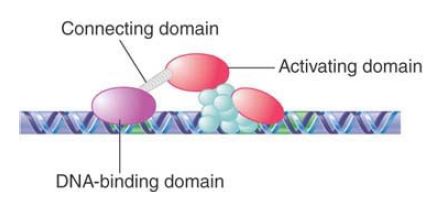


 النبات
النبات
 الحيوان
الحيوان
 الأحياء المجهرية
الأحياء المجهرية
 علم الأمراض
علم الأمراض
 التقانة الإحيائية
التقانة الإحيائية
 التقنية الحيوية المكروبية
التقنية الحيوية المكروبية
 التقنية الحياتية النانوية
التقنية الحياتية النانوية
 علم الأجنة
علم الأجنة
 الأحياء الجزيئي
الأحياء الجزيئي
 علم وظائف الأعضاء
علم وظائف الأعضاء
 الغدد
الغدد
 المضادات الحيوية
المضادات الحيوية|
Read More
Date: 1-12-2015
Date: 18-11-2020
Date: 29-11-2015
|
Independent Domains Bind DNA and Activate Transcription
Key concept
- DNA-binding and transcription-activation activities are carried out by independent domains of an activator.
- The role of the DNA-binding domain is to bring the transcription-activation domain into the vicinity of the promoter.
The actions of the activator class of transcription factors are the most well-known. Activators must be able to perform multiple functions:
- Activators recognize specific DNA target sequences located in enhancers that affect a particular target gene.
- Having bound to DNA, an activator exercises its function by binding to components of the basal transcription apparatus.
- Many activators require a dimerization domain to form complexes with other proteins.
Can the domains in the activator that are responsible for these activities be characterized? Often an activator has one domain that binds DNA and another, separate domain that activates transcription. Each domain behaves as a separate module that functions independently when it is linked to a domain of the other type. The geometry of the overall transcription complex must allow the activating domain to contact the basal apparatus irrespective of the exact location and orientation of the DNA-binding domain.
Enhancer elements near the promoter may still be an appreciable distance from the start point, and in many cases may be oriented in either direction. Enhancers may even be farther away and always show orientation independence. This organization has implications for both the DNA and proteins. The DNA may be looped or condensed in some way to allow the formation of the transcription complex, permitting interactions between factors bound at both the enhancer and the promoter. In addition, the domains of the activator may be connected in a flexible way, as illustrated in FIGURE 1. The main point here is that the DNA-binding and activating domains are independent and are connected in a way that allows the activating domain to interact with the basal apparatus irrespective of the orientation and exact location of the DNA-binding domain.

FIGURE 1 DNA-binding and activating functions in a transcription factor may comprise independent domains of the protein.
Binding to DNA is usually necessary for activating transcription, but some transcription factors function without a DNA-binding domain by virtue of protein–protein interactions. Does activation depend on the particular DNA-binding domain? This question has been answered by making hybrid proteins that consist of the DNAbinding domain of one activator linked to the activation domain of another activator. The hybrid functions in transcription at sites dictated by its DNA-binding domain, but in a way determined by its activation domain.
This result fits the modular view of transcription activators. The function of the DNA-binding domain is to bring the activation domain to the basal apparatus at the promoter. Precisely how or where it is bound to DNA is irrelevant, but once it is there, the activation domain can play its role. This explains why the exact locations of DNA-binding sites can vary. The ability of the two types of modules to function in hybrid proteins suggests that each domain of the protein folds independently into an active structure that is not influenced by the rest of the protein.



|
|
|
|
إجراء أول اختبار لدواء "ثوري" يتصدى لعدة أنواع من السرطان
|
|
|
|
|
|
|
دراسة تكشف "سببا غريبا" يعيق نمو الطيور
|
|
|
|
|
|
لأعضاء مدوّنة الكفيل السيد الصافي يؤكّد على تفعيل القصة والرواية المجسّدة للمبادئ الإسلامية والموجدة لحلول المشاكل المجتمعية
|
|
|
|
قسم الشؤون الفكرية يناقش سبل تعزيز التعاون المشترك مع المؤسّسات الأكاديمية في نيجيريا
|
|
|
|
ضمن برنامج عُرفاء المنصّة قسم التطوير يقيم ورشة في (فنّ الٕالقاء) لمنتسبي العتبة العباسية
|
|
|
|
وفد نيجيري يُشيد بمشروع المجمع العلمي لحفظ القرآن الكريم
|